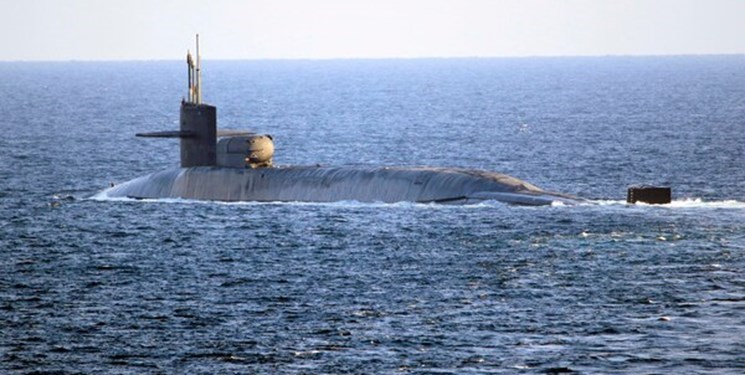Iranian Army Monitors USS Georgia Submarine in Strait of Hormuz during Electronic Warfare Drills
The Iranian Army forces on Tuesday flew a drone from the Central parts of the country where they are conducting massive electronic wargames to monitor the US Navy submarine, USS Georgia, as it was leaving the Strait of Hormuz in the Persian Gulf for 3 hours.

The Iranian Army has launched large-scale aerial drills involving electronic warfare units and featuring the country’s domestically-built air defense systems and equipment in the Central parts of the country.
Quick Reaction and electronic warfare units of the Army’s Ground Force, Air Force, Navy and Air Defense are participating in the joint aerial maneuvers, codenamed Sky Shield 1400, whose headquarters is located in Iran’s Central province of Isfahan.

Operations to detect and monitor signal information from ground and satellite stations, disruption and jamming of aircraft operations and use of positioning equipment and new systems mounted on helicopters were under focus in today’s Sky Shield electronic warfare exercises.
Smart and accurate performance of indigenous radar systems in detection of combat drones and small flying objects and performing more than one hundred operations in the field of electronic warfare with a desirable combination of techniques and tactics and using specialized and young experts and widespread use of drones in border areas are among the strong points of the drills.
One of the most important operations today was the three-hour surveillance of the US Navy nuclear-powered Ohio-class guided-missile submarine, USS Georgia (SSGN 729), while on exit from the Strait of Hormuz with drones participating in the exercises and sending images to the Command and Control Center of the joint drills.
Also, staging wargames by young officers in the form of two offensive and defensive teams of threat detection and identification and confronting the electronic capabilities of the hypothetical enemy was another part of the main stage of the exercises.
Iranian Deputy Commander for Coordination Rear Admiral Habibollah Sayyari said that the drills are the most practical exercises in the field of military electronic warfare in recent years.
He said the Iranian Army is going to use its latest achievements and combat capabilities during the drills, with offensive as well as defensive electronic warfare tactics to be put into practice.
Rear Admiral Sayyari also pointed to the high significance of electronic warfare in both operational and intelligence aspects of present-day military encounters, stressing that the Iranian Army has developed the necessary infrastructure for defense and electronic warfare.
During the drills, drones and smart micro aerial vehicles (MAVs) will also strike specified targets using electronic warfare cover, he said.
Rear Admiral Sayyari said aerial interception and cyber defense operations will also be conducted in the drill.
Furthermore, accuracy and speed in detection of aircraft will be analyzed, and electronic eavesdropping and jamming systems monitored.
Iranian military experts and technicians have in recent years made great progress in indigenously developing and manufacturing a broad range of equipment, making the armed forces self-sufficient in this regard.
Officials have repeatedly underscored that the Islamic Republic will not hesitate to build up its defense capabilities, emphasizing such abilities are entirely meant for the purpose of defense and will be never subject to negotiations.
Last week, Iran’s Army held cyber defense exercises codenamed ‘Fath 1’ to enhance their power in confrontation against attacks in the cyber space.
“Concurrent with increasing cyber defense power, we seek to enhance the military’s ability to counter cyber threats,” Rear Admiral Sayyari said on May 18 while making a snap visit to the drills’ zone along with Commander of the Iranian Army Major General Abdolrahim Mousavi.
He added that given the importance of the cyber space in promoting the ability to confront threats, the Iranian Army has taken extensive measures and has made significant progress in this field by training human resources, specially creative, capable and skilled youth.
“Staging other exercises on different scales is also planned which will be declared in the future, and the joint Fath 1 cyber defense drills is a successful instance of these exercises,” Rear Admiral Sayyari said.
Also, Deputy Commander of the Iranian Army for Information and Communication Technology Brigadier General Nasser Mokhtarzadeh said that assessment of strategic plans at the strategic, tactical, technical and operational levels, upgrading the planning power of decision makers, assessing and developing the cyber defense capability of the Islamic Republic of Iran, creating the ability to deal with cyber threats wisely and employing cyber officers alongside skilled elites to transfer know-how are a number of goals pursued by the cyber defense exercises.
He added that the country’s self-sufficiency in supplying technical security equipment led to adjusting the equipment to the type of attack during the drills which means that the cyber defense capability of the Army has changed from static to dynamic.
“Our young officers carried out defensive operations using local and global platforms and virtual groups of several hundred individuals,” General Mokhtarzadeh said.







